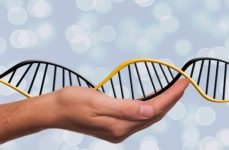 Have you had your DNA tested? At one time that question would have made no sense. Until the early 1950’s nobody knew that DNA–deoxyribonucleic acid—even existed, let alone what it was and how essential it is to all of life. As the blueprint for every aspect of an organism, DNA makes us who we are. It determines whether we have brown eyes or blue, are tall or short, are prone to certain diseases, even whether we tend to be outgoing or shy. DNA also makes us unique, so unless you have an identical twin, your DNA is different than everyone else on the planet.
Have you had your DNA tested? At one time that question would have made no sense. Until the early 1950’s nobody knew that DNA–deoxyribonucleic acid—even existed, let alone what it was and how essential it is to all of life. As the blueprint for every aspect of an organism, DNA makes us who we are. It determines whether we have brown eyes or blue, are tall or short, are prone to certain diseases, even whether we tend to be outgoing or shy. DNA also makes us unique, so unless you have an identical twin, your DNA is different than everyone else on the planet.
Most people are familiar with using DNA testing to identify criminals, or to establish familial relationships. DNA testing can also be used to discover where your ancestors likely lived and give clues to your ethnicity. In addition, it can help you find out if you have a tendency toward developing certain diseases. But DNA is incredibly complex, so there are limitations to the testing. What testing companies do is examine specific parts of your DNA and compare it to a database. That database looks for a relationship between a certain set of genes and those found in people who live or lived in a specific area of the world.
Some popular DNA tests for ethnicity are Ancestry, My Heritage DNA. Living History DNA and CRI Genetics. 23 and Me, Genos and Gene by Gene are other companies that do DNA testing, and they offer more options for using your results for health information, rather than simply ethnicity. At one time DNA testing was fairly expensive, $200 or more. Now these companies often have sales where you can purchase a basic genetic profile for as little as $69.
The most common DNA testing is autosomal chromosome testing, which looks at your non-sex-related genes. Males can also have Y-chromosome testing done, which traces their patrilineal heritage back through the generations. Females obviously can’t do this test because they don’t have a Y-chromosome. But everyone has a mother, so everyone can have their mitochondrial DNA tested to trace their maternal heritage. Both of these tests can give you general information about what part of the world your ancestors were from and help identify living relatives, although the Y-chromosome test gives much more specific results than the mitochondrial test does.
There are also special DNA testing services that specialize in testing ethnic groups associated with a specific region or culture, such as African, Native American or Jewish.
The actual test process is simple. You purchase a kit on-line and they send you the materials. You either spit saliva into a small vial, or use cotton swabs to swab the inside of your cheek. After doing this, you mail the test back and wait for the results, which takes several weeks.
How accurate are these tests? What you’re paying for is an “educated guess” based on the information that particular company has at the time. Different companies use different database information as well as different statistical methods to analyze it.
There was a news story this summer about a set of triplets who had their DNA tested by several companies. Their results should have come up as identical, since they have identical DNA, but two of the companies gave each triplet a different ethnicity profile. This example highlights just how complicated and imperfect this type of DNA testing is. Because different companies analyze different genetic markers, as well as having different ways of categorizing the data, the reality is: “results may vary”. While it can be fun to speculate on your ancestors’ ethnic background based on DNA testing, it isn’t nearly as accurate as detailed genealogical research, which can trace your actual ancestors to the place they lived. Genealogy Librarian Elaine Hayes plans to cover the crossover between DNA testing and genealogical research in another blog post.
Some fun facts about DNA tests for ethnicity:
Two siblings can come up with very different genetic profiles, even if they have the same parents. Although siblings inherit a lot of the same DNA, not all of their genetic material is identical. Just as you can take after your mother in appearance and look very different from your sibling who takes after your father, you may inherit your mother’s Scandinavian genetic characteristics, while your sibling inherits a primarily Irish DNA profile from your father.
National Geographic’s Geno 2.0 ethnicity test includes an analysis of the percentage of Neanderthal and Denisovan characteristics in your DNA. These are two ancient hominins species who lived in Europe and the Middle East at the same time as modern humans. They eventually became extinct, but not before some of them interbred with our ancestors. Some scientists believe as much as one fifth of our DNA is from Neanderthals. It primarily affects our appearance and the diseases we get, and bizarrely, can affect how difficult or easy it is for an individual to become addicted to cigarette smoking.
~Mary G.
